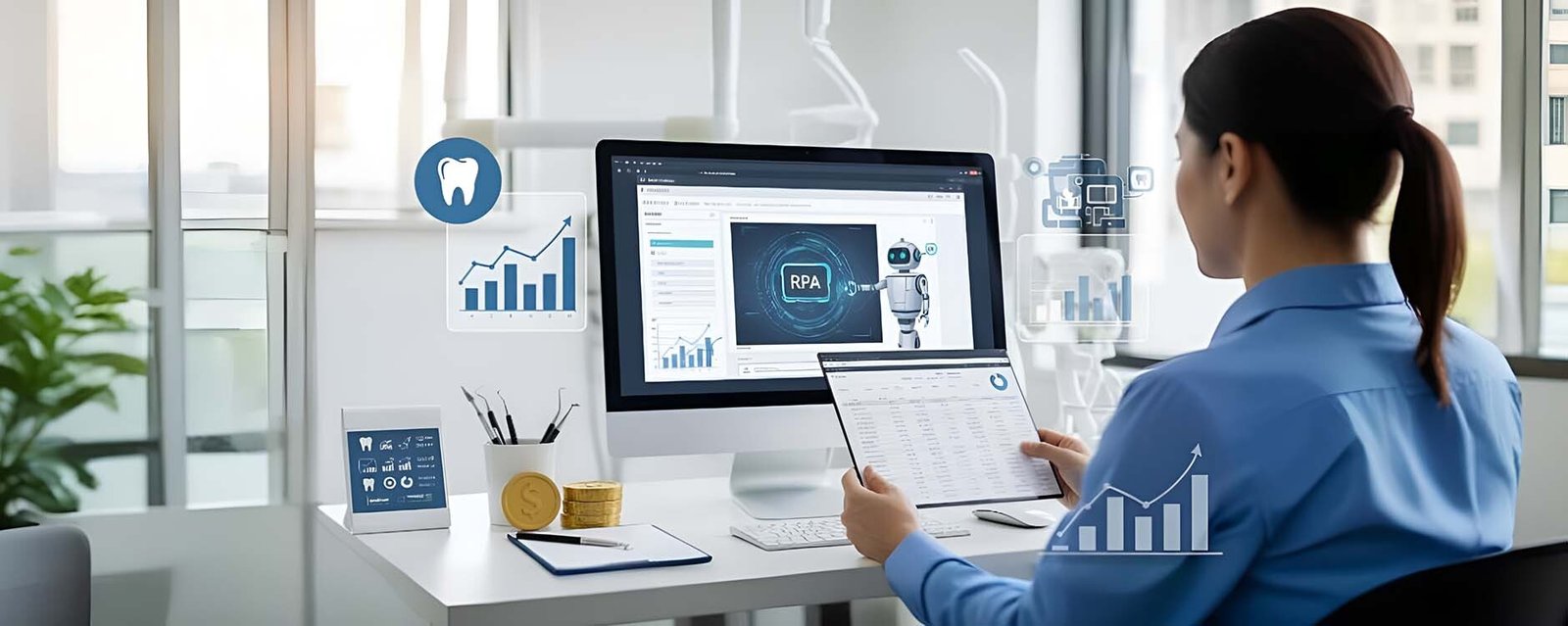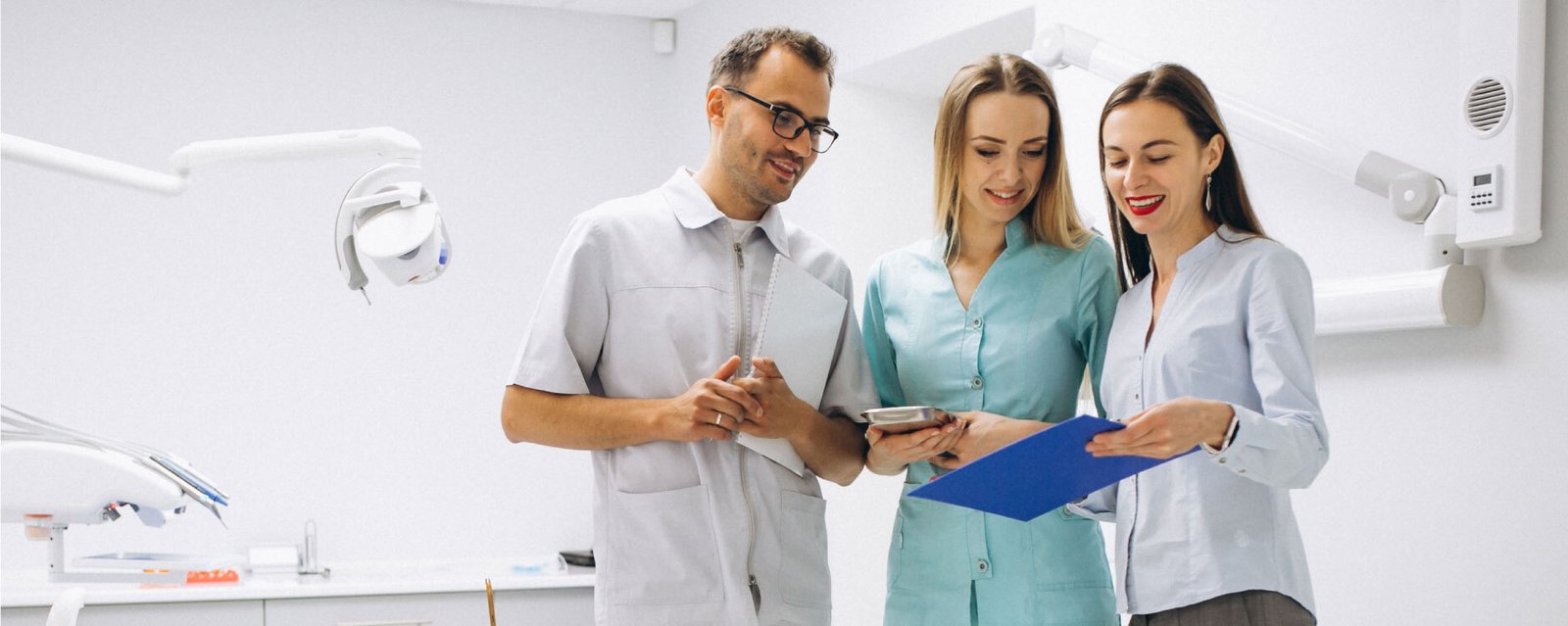56% of healthcare practitioners believe they’re losing out on revenue due to claim denials. These claims are often denied because practices often follow traditional practices and use outdated technology systems.
It drives the need for you to enhance your dental medical billing workflows by updating your practice management tools and patient portals. That’s where TransDental comes in, helping dental practices like yours improve workflows with smart RPA for dental medical billing.
By embracing AI, which is shaping the future of healthcare, you can take a big step toward simplifying your processes and preventing revenue loss. So, you can maintain a steady cash flow, all while focusing more on patient care.
Overview of RPA in Dental Billing
Before discussing the benefits of RPA in dental billing, it’s important to understand what it is and why its implementation is a must, not just an option.
So, RPA (robotic process automation) is a preprogrammed technology that can perform repetitive tasks based on the workflows instructed to it. It ensures accuracy and speed to make dental practices thrive and assists dental practitioners in experiencing maximum revenue growth.
Now, you must be wondering how RPA can help you achieve that. So, without further ado, let’s find out!
Benefits of Robotic Process Automation Dental Billing
Accuracy and Speed
Robust RPA systems automate the dental billing processes, whether it’s verifying patient insurance eligibility, preparing documentation for claims, or submitting the claims to the insurance companies.
In comparison to a human biller, RPA significantly accelerates the processes. While humans take time in checking and filling in each detail, RPA does that in just seconds. And all the details are entered and checked with near accuracy. This ensures claims are submitted and settled very quickly by totally eliminating manual errors.
Automated Eligibility Verification
Perhaps one of the biggest concerns for dental practices is eligibility verification. It’s the first and most crucial step in your entire dental billing process, as your entire process revolves around verifying patients’ eligibility details. Manual eligibility verification is prone to errors, which can disrupt processes and result in claim denials that hugely affect your revenue.
But an RPA system can automate eligibility verification by using preset rules and detecting errors with its intelligence. It accurately verifies patient details and checks the patient’s eligibility for a certain procedure, and available limits in the dental insurance plan.
By integrating with your payer portals, RPA cross-checks details. RPA approves a patient for an insured dental procedure only if the patient’s plan matches eligibility verification criteria. This improves the quality of your claim submissions, increasing your probability of maximizing collections.
Lower Practice Costs
When you’re dedicating billers to manage your billing, it costs you a lot while also taking up much of your staff’s time and affecting their productivity. You can imagine it with a single stat: an average biller’s salary is $48,999 per annum. If you break it down into months, it’s about $4,024 on average, meaning a huge expense for your dental practice.
You may need to hire multiple billers to handle billing tasks, depending on the complexity of a task, or you may rely on an expert biller to handle multiple tasks. But overwork can lead to staff burnout.
Here, this problem can be solved by investing in an RPA for dental medical billing, which guarantees you higher returns. These tools are built to cover billing tasks, usually handled by multiple billers, in one go. This reduces your administrative and operational overhead. The funds that you’ve spent on manual billing can be allocated to your dental practice, so you can enhance patient care.
Correct Documentation
RPA systems are tracking your entire dental revenue cycle management from a patient’s appointment scheduling to claims settlement. Under the supervision of dental billing experts, these systems prepare the correct documentation for your claim forms.
These documents include, but are not limited to, all of the dentist’s notes, and other important elements like prescriptions, X-ray reports, tests, pre-authorization for certain treatments, lab slips to verify costs for tests, and a written dentist’s order that necessitates a dental procedure. Some documents are required for certain dental procedures, such as periodontal charts for periodontal treatments like root planning, osseous surgery, mouth debridement, and periodontal maintenance.
RPA attaches the right documents for each dental procedure and insurance company’s requirements, ensuring there are no obstacles to your claim settlements.
Precise Dental Coding
Despite years of experience, manual dental coders can make mistakes while adding codes for each dental procedure during the claims submission process. After all, the American Dental Association (ADA) keeps revising the CDT codes annually, and keeping track of the latest codes can be challenging for your staff. And using the right CDT code is essential to getting your claims approved by insurers.
By implementing RPA in dental medical coding, you can reduce claim denials. RPA fetches the exact CDT codes for a dental procedure and the CPT codes for dental issues requiring medical procedures. The RPA system uses these appropriate codes for your claims form. This ensures that your claims are submitted without any hassle and you recover your amount sooner than you ever expected.
Real-Time Claims Tracking and Reports
Chasing insurers to track the progress of your claims and ensuring they’re settled and reimbursed in your accounts is a time-consuming process.
But RPA systems automatically track the progress of your submitted claims and generate real-time reports to update you on the ongoing status. These reports offer transparency, boosting your confidence levels in an RPA system. With this satisfaction, you can fully devote yourself to restoring your patients’ smiles, letting RPA handle the billing and pursue insurance companies.
Instant Claims Settlement
Insurance companies take a lot of time to settle dental claims after the submission of requests. Manually submitted claims are settled around 2-4 weeks, while it takes 7-8 business days to settle electronically submitted claims. In any case, it results in longer wait times, disrupting your dental practice’s cash flow.
In contradiction, an excellent RPA for dental medical billing fulfills the job very soon. It requires no longer than 48 hours to get your claims settled after submission, and post them in your patient ledgers. These systems work much faster than manual billers, with very less chances of errors. Quick payments mean a healthy cash flow and steady financial management for your dental practice.
Timely Denial Management
When claims are denied by insurance companies for any reason, it affects your dental practice’s finances and daily operations. Since you haven’t recovered your amount and have to put in effort to resubmit claims, you can experience a spike in your costs.
RPAs track your claim denials on time, identify their reasons, and automatically process appeals to the insurance companies for claims settlement. These systems do it with precision, leaving no reason for insurers to deny your claim requests.
On average, 30-60 days are required to settle claims after denials, but top RPA solutions can settle them in less than 26 days.
Billing Audits to Identify Gaps
Sometimes, errors can occur while you’re submitting claims. You either charge your insurers less for a dental procedure or charge them more. If you undercharge, it results in financial loss for your dental procedure. And if you overcharge on a procedure, insurers stop trusting you and complain about you, which can lead to external audits on your practice, fines and penalties for not adhering to regulatory compliance, and eventual reputational damage.
RPAs are designed for your convenience to protect your dental practice from these issues. The automated systems evaluate your dental billing from time to time, performing monthly or annual audits to identify any loopholes in your billing process. Automatic reports are generated, so you know the mistakes in dental billing and can take steps to prevent them in the future.
In case of undercharging or overcharging, you can contact your payers and negotiate with them accordingly, so both parties are compensated fairly.
Faster A/R Recovery
Aged accounts receivable (A/R) refers to dues with pending payments by patients. These are aging after over 90 days, and aging A/R can cost practices up to $180,000, as found in a recent survey. During manual audits, aging A/R can get ignored, and you may not even know about the potential amount you can recover.
RPA tools make this faster and easier. These systems don’t just detect your A/R through billing audits and real-time checks of your financial database, but also try to resolve your A/R as soon as possible. With strategic follow-ups on AR by communication experts, chances are that payments can be recovered within 24 days.
Conclusion
There is no denying the fact that robotic process automation is the future. With automated processes, near-complete accuracy, and ultra-fast processes, RPA for dental medical billing is a viable option for your dental practice to maximize collections from your claims settlements, billing audits, and A/R.
With RPA-powered timely actions, you can recover a significant portion of your amount. This leads to a steady cash flow, helping your dental practice thrive and empowering you to provide quality care to patients who trust you to restore their smiles.
So, don’t stay behind in the competition, and invest in cost-effective and high-quality RPA solutions to take your dental billing to the next level!
Frequently Asked Questions (FAQs)
Can I customize what RPA does in my practice?
The RPA system works according to preset rules, and you can customize RPA workflows, controlling all the aspects of your dental practice that it should handle.
What happens if RPA doesn’t work properly or shows technical glitches?
Your RPA service provider offers support and monitors the system to identify glitches and make timely fixes.
Is RPA hard to set up?
An RPA service provider can easily set up the RPA system. It can be integrated with your EHR systems and payer portals to fetch important data and manage your practice’s dental billing.
How soon will I see results from using RPA?
There isn’t a set timeframe, but RPA systems can usually deliver results quickly. RPA systems process claims with near accuracy, eliminating manual errors, and ensuring claims are settled fully.
Can RPA be used for specialty practices like oral surgery or ortho?
RPA systems can be customized for all dental practices, whether general or specialty-based facilities, and handle aspects tailored to oral surgery, orthodontics, periodontics, and other dental specialties.





